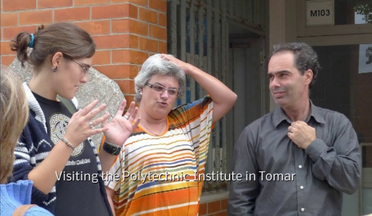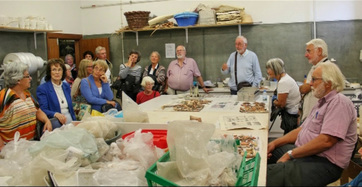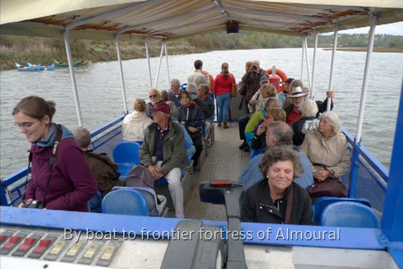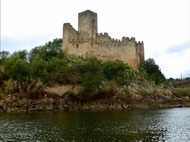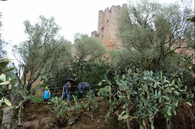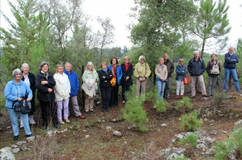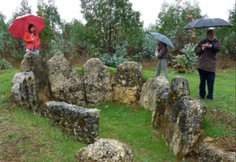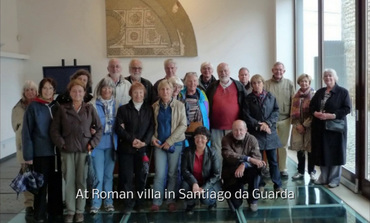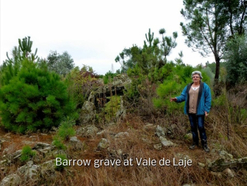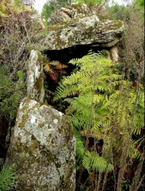2012 - Oct : AAA visit to Tomar, Alviazere and Val de Laje
Following the October lecture of Sara Garçes we met up with her again for the AAA tour. The tour began at the Polytechnic Institute in Tomar. Here a project examining the cultural differences between two adjacent Meso/Neolithic populations in a nearby region was displayed and discussed.
|
Two rivers, the Naboa to the west and the Zezere to the east, flow southwards to a confluence and thence to the Tagus. The Naboa (N) basin has sedimentary geology and the Zezere (Z) has igneous rocks. The N group practiced inhumations in caves, the Z group used dolmens. Their ceramics were different in style but identical in technique and their microliths were identical. Maybe the differential inhumation practice is attributable to the absence of caves in the igneous region. A common source for the arrowhead was postulated by one member of our group to explain the very superior technique employed by their manufacture. The Institute’s ossuary contains, besides an erratic dinosaur rib from Cabo Espichel, many Neolithic bones and teeth from Extramadura. The polymorphic features of the teeth and jawbones are being studied (a first for Portugal) to elucidate genetic links. More data and more statistical work are needed to put these studies on a firm basis, early work in this field concentrated on remote exotic populations eg Inuits and produced theories now considered to be unreliable.
|
|
On the second day we made a visit with Sara Garçes to the Convent/Castle complex in Tomar, having been established in the 12th century by Gualdim Paes, Master of the Templars. At this time Tomar was on the frontier between the Portuguese and the Moors. When the Templars were suppressed in the 14th century, the king of Portugal preserved the local charters by transmuting them into a new Order of Christ. The huge complex which contains a central church exhibiting Byzantine influences derived from buildings in Jerusalem. |
Click image to start/stop slideshow
|
It has a grandiose charola with 8 pillars commemorating the 8 founding Templar warriors. Money flowed from the early modern Portuguese maritime empire for the buildings further expansion and decoration. A local quirk was the burial of monks in a standing position. Water to the complex was supplied by a 6km aqueduct of a later date.
The churches of St. John the Baptist and Sta Maria were then visited; both having interesting and unusual features.
The churches of St. John the Baptist and Sta Maria were then visited; both having interesting and unusual features.
The Museum at Alviazere was visited on the next day. The notable collections are of bicycles (both pedal and motorized) and local crafts. There is a small archaeology collection ranging from Paleolithic tools to Roman artefacts.
|
At the megalithic complex at Ramahal we saw a barrow grave about 16m in circumference. The remains of around 50 Neolithic people were recovered in an excavation started in 1978. Nearby there was a second opened barrow which is similar in design, size and orientation (SE) to the first. There were 2 phases of occupation, no rock art in the chamber (unlike the first) and some pieces of copper. It was noted that the Portuguese law does not adequately protect megalithic remains and indeed serves to promote rather than deter robbery as can be seen by the removal of a capstone for reuse in an oil press.
|
|
The Roman villa and Medieval tower and restored dwelling at Santiago da Guarda were viewed. The villa had many large and interesting mosaics including excellent trompe l’oieul borders and what seemed to be a labyrinth with open swastikas and corridors all encompassing guioches. The adjacent and surmounting medieval architecture included an impressive peel tower confirming that this was a frontier area of the reconquest.
|
